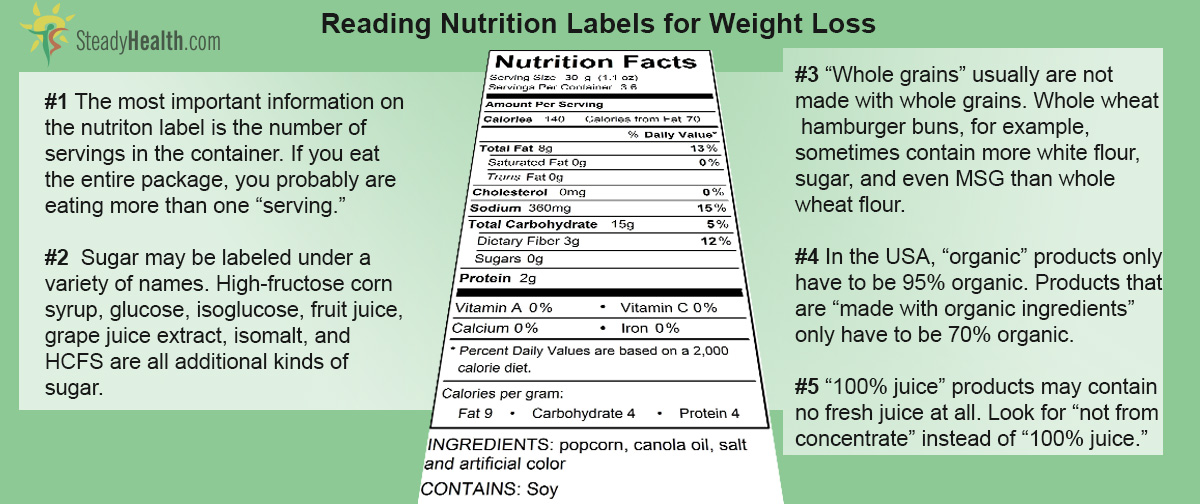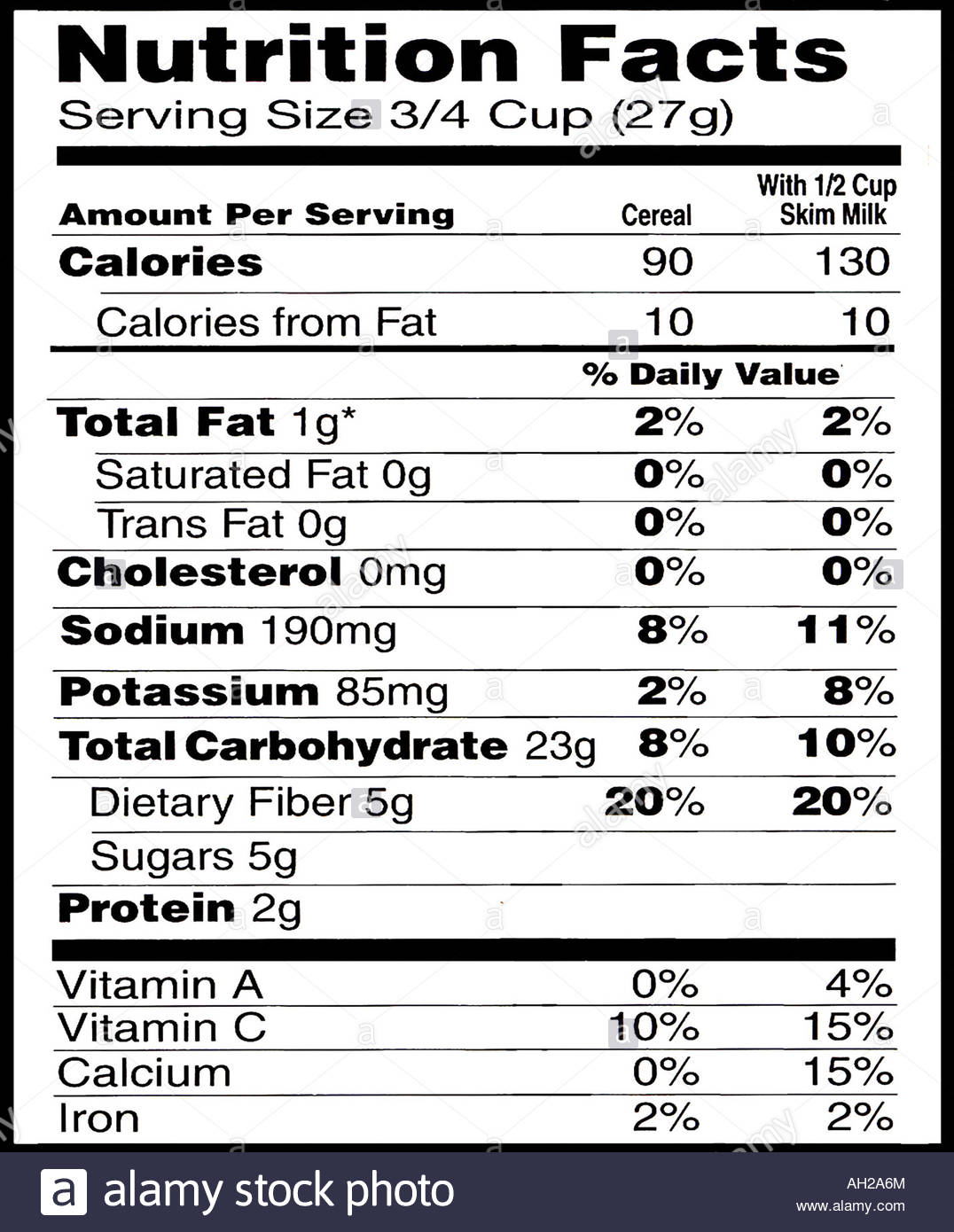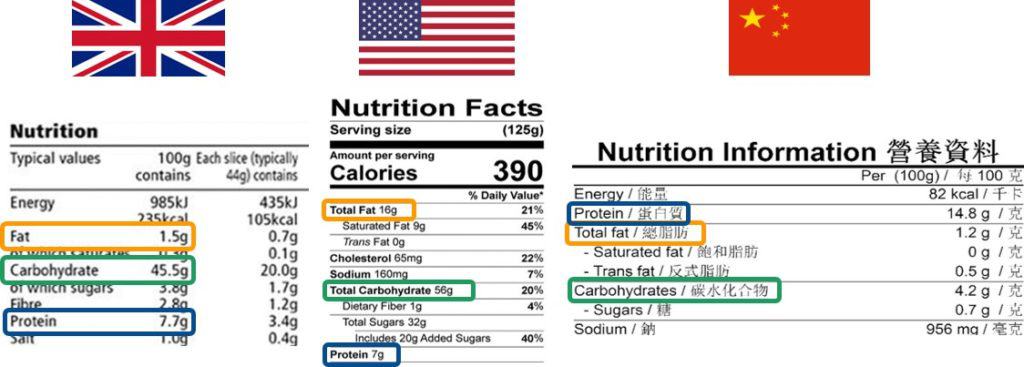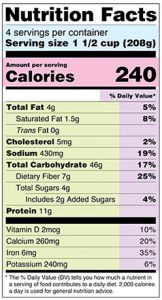40 how to read nutrition food labels
How to Read a Nutrition Label — Tsirona Nutrition labels help to tell you what's in the food you're buying, but they can be quite tricky to navigate. When you're trying to be mindful of what you're consuming, the confusion nutrition labels bring can make it that much more difficult. ... Before long, you'll be a nutrition label reading pro! Soothing Summer Foods Guide. What you eat ... How to read food labels | healthdirect The label will tell you: the name of the product, describing accurately what it is the brand name what ingredients it contains (listed in order from largest to smallest by weight) nutritional information (such as average amount of energy, fat, protein, sugars and salt)
How to Understand and Use the Nutrition Facts Label | FDA For certain products that are larger than a single serving but that could be consumed in one sitting or multiple sittings, manufacturers will have to provide "dual column" labels to indicate the...

How to read nutrition food labels
PDF How to Read the Food Label - Risk Services Look for low- sodium foods with less than 140 mg per serving. Track the total amount you eat. Fiber. Aim for 25 to 38 grams of fiber per day. Sugars: Limit added sugars. Some vitamins and minerals may be listed with DV in one serving. Percent Daily Values (DV) tell you how much you should be eating based on a 2,000 or 2,500 calorie diet. How to Read a Nutrition Facts Label | Everyday Health The nutrition facts label on packaged foods contains vital information about a food's nutritional value that can help people make healthy dietary choices. Recent changes to the nutrition facts label were made to present this information in a way that's easier to understand, and if you know what to look, you'll be able to maintain a healthy diet and take care of any special dietary needs. How to read food labels: MedlinePlus Medical Encyclopedia If a label says that a food has 100 mg of sodium, this means it has about 250 mg of salt. You should eat no more than 2,300 mg of sodium per day. This is the amount of sodium that is in 1 measuring teaspoon of table salt. Ask your health care provider if you should have even less. The % daily value is included on the label as a guide.
How to read nutrition food labels. PDF How Do I Understand the "Nutrition Facts" Label? Nutrition Facts label and ingredient list. When you go grocery shopping, take time to read the Nutrition Facts labels on the foods you purchase. Compare the nutrients and calories in one food to those in another. The information may surprise you. Make sure you aren't buying foods high in calories, saturated fat, trans fat, sodium and added ... safefood | How to read food labels Then when you are shopping, compare labels of similar products to find the healthiest option. Here are the things to look out for. What's on the label? Nutrition information can be found on the back/side of food labels. Sometimes you will also find a snapshot of this information on the front of pack. Nutrition information is displayed per ... How to Read a Nutrition Label - Lakanto A nutrition label can be broken down into six sections. 1. Serving Size. The serving size is right under the "Nutrition Facts" title. The bolded line is the recommended serving size for that food product. The serving size is listed in a simple measurement, such as cups and pieces, with its grams or ounces equivalent. How to read nutrition labels | safefood Nutrition information can be found on the back/side of food labels. Sometimes you will also find a snapshot of this information on the front of pack. Nutrition information is displayed per 100g and sometimes per recommended serving. Use the per 100g column to compare products. Look at the recommended portion size.
How to Read Nutrition Facts Label - Food Network Serving sizes are a useful tool for telling us how many nutrients we're consuming. When you take a look toward the top of the Nutrition Facts label you'll see the servings per container and the... How to Read Food Nutrition Labels - Maine SNAP-Ed Nutrition Facts: quick label tips. On your next shopping trip, be sure to use one or more of these tips when looking at a food label: Look at the serving size. Does the package contain more than one serving? Cross-check the nutrition facts with the ingredient list. Food that has less than 1 gram of trans fat per serving can list that the ... PDF How to Read a Food Nutrition Label - Veterans Affairs size" is the official term used on food labels. Nutrition facts given on the food label are based on one serving. Be sure to look at the number of servings in the container. Even small containers may have more than one serving. If you eat the whole container, then you must multiply the nutrition values by the number of servings in the ... How to Read Nutrition Facts | Food Labels Made Easy - YouTube To support our channel and level up your health, check out:Our Fast Weight Loss Course: B...
Understanding Food Labels | The Nutrition Source | Harvard T.H. Chan ... The percent Daily Value (%DV) shows how much of a nutrient in one serving of food contributes to one's approximate daily requirement for the nutrient. To best use the %DV, remember these simple guidelines: 5% DV or less of a nutrient per serving is considered low. How to Read Food Labels Without Being Tricked - Healthline A good rule of thumb is to scan the first three ingredients, as they make up the largest part of what you're eating. If the first ingredients include refined grains, a type of sugar, or... How to Read a Nutrition Label - dummies About the book authors: Jane Kirby, RD is a registered dietitian and member of the American Dietetic Association. She is the food and nutrition editor of Real Simple magazine and owner of The Vermont Cooking School, Inc TM in Charlotte, Vermont. Jane is the former editor of Eating Well magazine and the food and nuitrition editor for Glamour.She served on the dietetics staff of the ... How To Read Food and Beverage Labels | National Institute on Aging At the top of the Nutrition Facts label, you will find the total number of servings in the container and the food or beverage's serving size. The serving size on the label is based on the amount of food that people may typically eat at one time and is not a recommendation of how much to eat. Read more about serving and portion sizes.
Food label reading guide | Nutrition Australia When reading the NIP: • always read the per 100g column to compare similar products, because the serve sizes differ between brands. • always compare similar products, for example compare one brand of yoghurt with another brand of yoghurt. What to look for when reading food and drink labels (per 100g) Health Star Ratings
Learning To Read Labels :: Diabetes Education Online The "Nutrition Facts Label" is found on the outside of the container. To count carbohydrates, look at three things: Serving Size Number of Servings Per Container Grams of Total Carbohydrate per serving The total carbohydrate tells how many grams of carbohydrate are in one serving. Be careful when reading the label.
How to Read a Nutrition Facts Label - The Family Meal Project The nutrition terms on the label are there to tell you more about some of the nutrients in the food item you are looking at. Calorie Free - less than 5 calories per serving. Low Calorie - 40 calories or less per serving. Fat Free/Sugar Free - less than 1/2 gram of fat or sugar per serving. Low Fat - 3 grams or less of fat per serving.
How To Read A Food Nutrition Label | Gobble To learn how to read food nutrition labels, start at the top with serving size. Serving Information The serving size is the amount of specific food or drink you should consume in one sitting. This number is usually the first thing listed on the nutrition label because it provides important context for everything else.
How To Read Nutrition Labels (Like a Pro) - Ditch The Carbs The front of the box states it is high in fibre, cholesterol-lowering and has a 4.5 star rating, but look at the nutrition label and it tells another story. Per ¾ cup serving (and most people serve 1-2 cups) + ½ cup milk = 37.9g carbs, 15.5g sugars. The only reason it has any vitamins is because it has been fortified.
How To Read Nutrition Food Labels And Eat Healthy - Scripps Health Food packages often contain multiple servings. For certain packages, labels need to show the number of calories and nutritional value per serving and per package or container. "Always check the serving size first and the number of servings listed on the label of the package," Dr. Cheng says. "The serving size is not a recommendation.
Understanding Food Nutrition Labels | American Heart Association 1 - Start with the serving information at the top. This will tell you the size of a single serving and the total number of servings per container (package). 2 - Next, check total calories per serving and container. Pay attention to the calories per serving and how many calories you're really consuming if you eat the whole package.
How to understand food labels - Eat For Health The Nutrition Information Panel on a food label offers the simplest and easiest way to choose foods with less saturated fat, salt (sodium), added sugars and kilojoules, and more fibre. It can also be used to decide how large one serve of a food group choice or discretionary food would be and whether it's worth the kilojoules.
Food labels - NHS Nutrition labels are often displayed as a panel or grid on the back or side of packaging. This type of label includes information on energy (kJ/kcal), fat, ...
Reading Food Nutrition Labels 101 and How to Decode Them So, the first thing I want to do is give you a list of the rules for reading a nutritional food label. 8 Rules for Reading Food Nutrition Labels: Never believe the flashy claims on the front of the box. Always read the nutrition facts label and the ingredient list. Check the serving size. Check the amount of servings per package. Check the ...

"Your greatest self has been waiting your whole life; dont make it wait any longer" : Nutrition ...
3 Ways to Read Nutrition Facts on Food Labels - wikiHow Protein is essential when it comes to promoting healthy muscle growth and maintaining a good energy level throughout your day. 9. Know that 5% of a daily value per serving is low and 20% is high. When it comes to nutrients, 5% or less is considered low and 20% or higher is considered high.
Food Labels | CDC Check the Serving size first. All the numbers on this label are for a 2/3-cup serving. This package has 8 servings. If you eat the whole thing, you are eating 8 times the amount of calories, carbs, fat, etc., shown on the label. Total Carbohydrate shows you types of carbs in the food, including sugar and fiber.
How to read food labels: MedlinePlus Medical Encyclopedia If a label says that a food has 100 mg of sodium, this means it has about 250 mg of salt. You should eat no more than 2,300 mg of sodium per day. This is the amount of sodium that is in 1 measuring teaspoon of table salt. Ask your health care provider if you should have even less. The % daily value is included on the label as a guide.

How To Read Nutrition Labels For Weight Loss And For General Health | Weight Loss articles ...
How to Read a Nutrition Facts Label | Everyday Health The nutrition facts label on packaged foods contains vital information about a food's nutritional value that can help people make healthy dietary choices. Recent changes to the nutrition facts label were made to present this information in a way that's easier to understand, and if you know what to look, you'll be able to maintain a healthy diet and take care of any special dietary needs.
PDF How to Read the Food Label - Risk Services Look for low- sodium foods with less than 140 mg per serving. Track the total amount you eat. Fiber. Aim for 25 to 38 grams of fiber per day. Sugars: Limit added sugars. Some vitamins and minerals may be listed with DV in one serving. Percent Daily Values (DV) tell you how much you should be eating based on a 2,000 or 2,500 calorie diet.











Post a Comment for "40 how to read nutrition food labels"